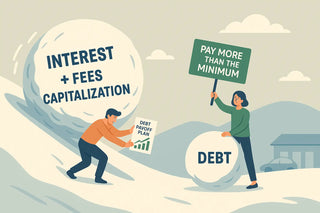Loans can be a helpful tool — whether you’re paying for a home, car, or education. But if you’re not careful, that loan balance can quietly grow larger than you ever expected.
So, let’s get to the core question:
What increases your total loan balance?
In this guide, we’ll break down the top factors that cause loan balances to rise — and what you can do to stop the snowball effect.
1. 💸 Interest Accruing Over Time
The number one reason loan balances grow is simple: interest.
Every time you make a payment, a portion goes to interest, and the rest goes toward the principal. If you’re only making minimum payments, or if interest is high, the loan balance shrinks very slowly — or may even grow.
This is especially true with loans like:
-
Credit cards
-
Student loans (especially unsubsidized)
-
Payday loans
-
Long-term car loans
💡 Curious about why car payments feel never-ending? Learn more in Why Americans Believe Car Payments Are Normal.
2. 🕰️ Deferring Payments or Forbearance
Taking a break from payments might feel like relief now, but it often means your interest continues to accumulate, even if you’re not actively paying.
For example:
-
Student loans in deferment: Interest on unsubsidized loans still builds up.
-
Forbearance during hardship: May pause payments, but interest keeps growing.
When you finally resume payments, the unpaid interest often gets added to your principal balance — this is called capitalization.
3. 💳 Late Fees and Penalties
Miss a payment?
Your lender may hit you with:
-
Late fees
-
Increased interest rates (penalty APRs)
-
Additional charges for bounced payments
These charges add directly to your loan balance, making it even harder to catch up.
4. 🏦 Capitalized Interest
Here’s a tricky one: capitalization.
When you postpone payments (like in deferment, forbearance, or certain income-driven repayment plans), the interest that accrues doesn’t just sit there — it eventually gets added to your principal. This means:
-
Future interest is calculated on the larger balance
-
Your total repayment amount grows significantly over time
It’s a debt snowball effect in the wrong direction.
5. 📈 Adjustable Interest Rates
If you have a loan with a variable or adjustable interest rate, your payments can increase when rates go up — and so can your balance if you can’t keep up with the higher costs.
This is common with:
-
Adjustable-rate mortgages (ARMs)
-
Certain private student loans
-
Credit cards tied to the prime rate
Always read the fine print to know if your interest rate could change.
6. 🚗 Rolling Old Debt Into New Loans
It’s common to roll existing debt into a new loan when refinancing or upgrading. But this can backfire if:
-
The new loan has a longer term (more interest paid over time)
-
You add more debt (like trading in a car with negative equity)
Instead of shrinking your debt, you could be growing it — often without realizing it.
How to Stop Loan Balances from Growing
✅ Pay more than the minimum
✅ Avoid deferring payments unless absolutely necessary
✅ Pay interest during deferment or forbearance if you can
✅ Understand the terms of your loan (fixed vs. variable rates)
✅ Create a debt payoff plan (like the debt avalanche or snowball method)
Need a reality check on how small habits impact your finances? Read 2 Questions Smart Spenders Ask Before a Purchase to rethink spending.
Final Takeaway: Knowledge Is Power
So, what increases your total loan balance?
Here’s the quick list:
-
Accrued interest
-
Deferred or paused payments
-
Late fees and penalties
-
Capitalized interest
-
Variable interest rate hikes
-
Rolling old debt into new loans
The good news? Once you understand these factors, you can take action.
At Smart Financial Lifestyle, we believe that smart money choices today lead to financial freedom tomorrow.
The key is learning how debt works — and how to keep it working for you, not against you.
